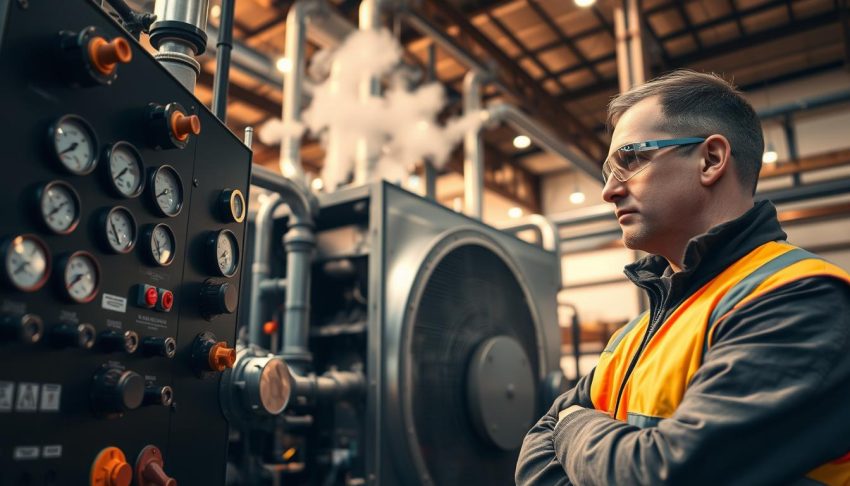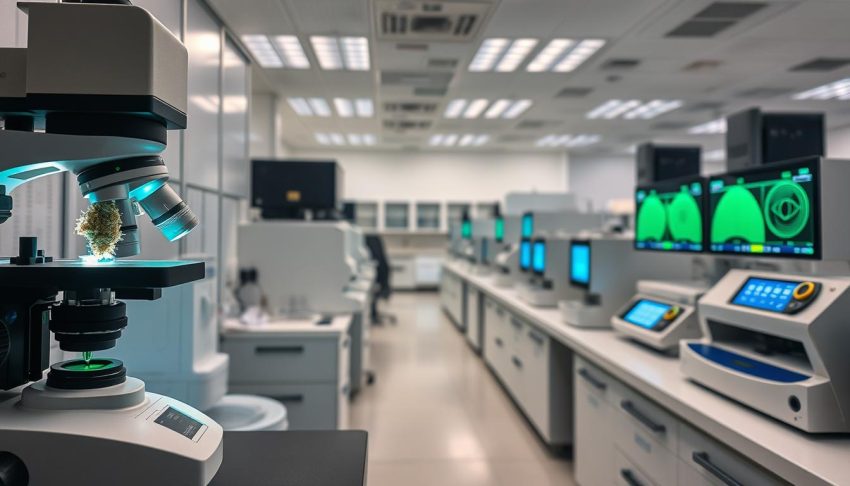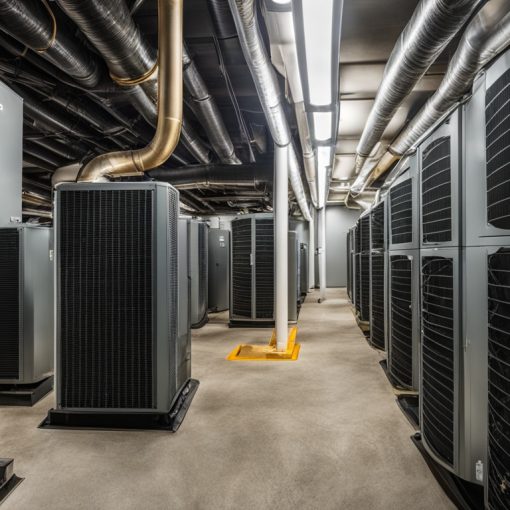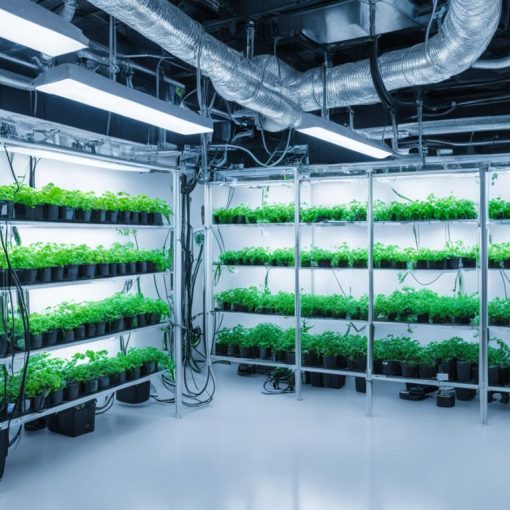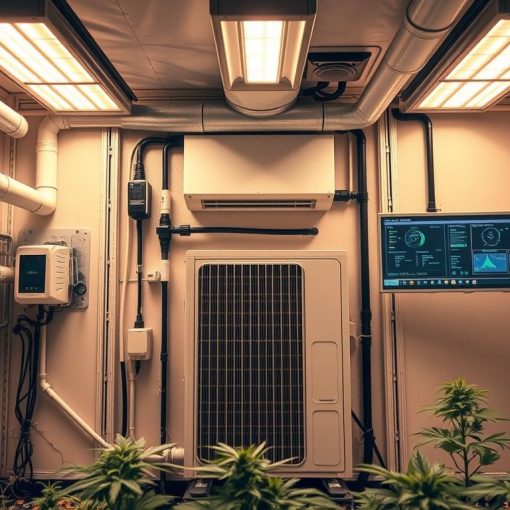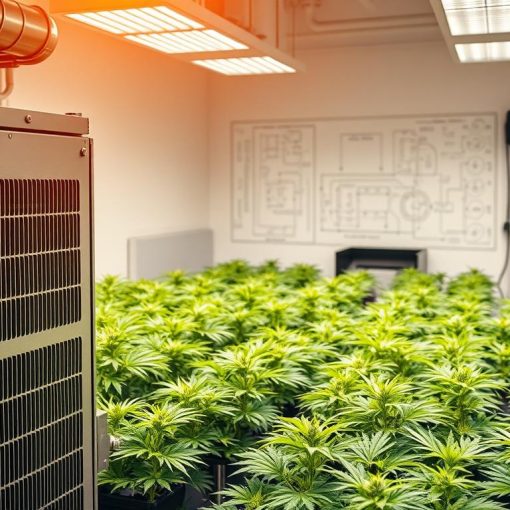The cannabis industry is rapidly evolving, with innovative technologies like Hot Gas ReHeat playing a crucial role in enhancing cannabis processing. This method has revolutionized the way cannabis is dried and processed, offering a more efficient and effective solution.
Cannabis processing involves several critical steps, including drying, curing, and extraction. The Hot Gas ReHeat technology has emerged as a game-changer in this domain, providing a reliable method for improving the quality and consistency of cannabis products.
Key Takeaways
- Understanding the basics of Hot Gas ReHeat technology and its application in cannabis processing.
- The benefits of using Hot Gas ReHeat in cannabis drying methods.
- How Hot Gas ReHeat technology is transforming the cannabis industry.
- Best practices for implementing Hot Gas ReHeat in cannabis processing facilities.
- The future of cannabis processing with advancements in Hot Gas ReHeat technology.
The Science and Principles of Hot Gas ReHeat Technology
The principles of Hot Gas ReHeat technology are rooted in advanced thermodynamic processes. This technology has revolutionized the cannabis industry by providing a more efficient and effective method for processing cannabis.
Thermodynamic Fundamentals of Hot Gas Processing
Hot Gas ReHeat technology operates on the principles of thermodynamics, where hot gas is used to transfer heat to the cannabis material. This process is governed by the laws of thermodynamics, which dictate how energy is transferred and utilized.
Thermodynamic efficiency is crucial in this process, as it directly impacts the quality and consistency of the final product. By understanding the thermodynamic fundamentals, operators can optimize the processing conditions to achieve the desired outcomes.
Heat Transfer Mechanisms in Cannabis Material
The effectiveness of Hot Gas ReHeat technology largely depends on the heat transfer mechanisms within the cannabis material. There are primarily two mechanisms at play: conduction and convection.
Conduction vs. Convection Effects
Conduction refers to the transfer of heat through direct contact between particles, whereas convection involves the transfer of heat through the movement of fluids. In the context of Hot Gas ReHeat, convection plays a significant role as the hot gas flows around the cannabis material, efficiently transferring heat.
“The use of hot gas in cannabis processing leverages the benefits of convection, allowing for uniform heating and reduced processing times,” as noted by industry experts. This highlights the importance of understanding and optimizing the heat transfer mechanisms for high-quality cannabis products.
By grasping these fundamental principles, cannabis processors can better utilize Hot Gas ReHeat technology to enhance their operations and product quality.
Benefits of Hot Gas ReHeat Cannabis Processing
Hot Gas ReHeat cannabis processing offers several key benefits that improve product quality and production efficiency. This technology has been shown to enhance the overall quality of cannabis products while streamlining the processing stage.
Enhanced Cannabinoid Preservation
One of the primary advantages of Hot Gas ReHeat technology is its ability to preserve cannabinoids effectively. By controlling temperature and humidity, this method minimizes the degradation of sensitive cannabinoids, resulting in a higher potency product. Studies have shown that cannabinoid preservation is significantly improved when using Hot Gas ReHeat compared to traditional drying methods.
Terpene Profile Protection and Enhancement
In addition to cannabinoid preservation, Hot Gas ReHeat technology also protects and enhances the terpene profile of cannabis. Terpenes are crucial for the aroma and flavor of cannabis products, and their preservation is essential for maintaining product quality. The controlled environment of Hot Gas ReHeat systems helps in retaining these delicate compounds, ensuring a more flavorful and aromatic final product.
Reduced Processing Time and Increased Throughput
Hot Gas ReHeat technology significantly reduces processing time by efficiently managing the drying process. This not only accelerates production but also allows for increased throughput, enabling cannabis producers to meet growing demand more effectively. The efficiency gained through this technology can be a critical competitive advantage in the rapidly expanding cannabis market.
Production Efficiency Metrics
To quantify the benefits of Hot Gas ReHeat technology, producers can track several production efficiency metrics, including:
- Processing time reduction
- Throughput increase
- Energy consumption per unit
- Product yield and quality consistency
By analyzing these metrics, cannabis producers can optimize their Hot Gas ReHeat systems to achieve maximum efficiency and product quality.
Essential Equipment for Hot Gas ReHeat Cannabis Systems
Implementing Hot Gas ReHeat technology for cannabis processing requires specialized equipment designed to optimize efficiency and product quality. The core components of these systems are crucial for achieving the desired outcomes in cannabis drying and processing.
Core Components and Technical Specifications
The effectiveness of Hot Gas ReHeat systems is largely dependent on the technical specifications of their core components. These include high-efficiency heaters, advanced air circulation systems, and precision temperature control units. The heaters are designed to provide consistent heat, while the air circulation systems ensure uniform drying. Temperature control units are critical for maintaining the optimal temperature for cannabinoid and terpene preservation.
Commercial-Scale Systems vs. Craft Production Options
Hot Gas ReHeat equipment is available in various configurations to suit different production scales. Commercial-scale systems are designed for large-volume processing, offering high throughput and efficiency. In contrast, craft production options cater to smaller operations, providing flexibility and the ability to process smaller batches. The choice between these options depends on the specific needs and capacity of the cannabis producer.
Automation and Control Systems
Automation plays a vital role in modern cannabis processing, including Hot Gas ReHeat systems. Advanced automation and control systems enable precise control over the drying process, ensuring consistent product quality. These systems can be programmed to adjust parameters such as temperature, humidity, and airflow, optimizing the process for different cannabis strains.
Monitoring Software and Integration
The integration of monitoring software with Hot Gas ReHeat systems allows for real-time monitoring and adjustments. This software can track critical parameters and provide insights into the processing conditions, enabling operators to make data-driven decisions to optimize the process.
Hot Gas ReHeat Cannabis: Step-by-Step Implementation Guide
To achieve optimal results with Hot Gas ReHeat cannabis processing, follow a detailed step-by-step guide. This comprehensive guide will walk you through the essential steps to ensure high-quality output and efficient processing.
Pre-Processing Preparation Requirements
Before initiating the Hot Gas ReHeat process, it’s crucial to prepare the cannabis material properly. This includes:
- Trimming and curing the cannabis to the appropriate level
- Ensuring the material is dry enough for processing
- Sorting and grading the cannabis for consistent quality
According to industry experts, “Proper pre-processing preparation is key to achieving consistent and high-quality cannabis products.”
“The quality of the final product is directly related to the quality of the initial material and its preparation.” –
Temperature and Humidity Parameter Settings
Setting the correct temperature and humidity parameters is vital for effective Hot Gas ReHeat processing. The ideal settings may vary depending on the specific cannabis strain and desired outcome.
| Parameter | Range | Optimal Value |
|---|---|---|
| Temperature (°C) | 40-60 | 50 |
| Humidity (%) | 30-50 | 40 |
Processing Phases and Timing Protocols
The Hot Gas ReHeat process involves several phases, each with specific timing protocols. Understanding these phases is crucial for achieving the desired results.
- Initial heating phase: Gradually increase the temperature to the set point.
- Stabilization phase: Maintain the temperature and humidity for a specified period.
- Cooling phase: Gradually decrease the temperature to stop the process.
Critical Control Points and Quality Checks
To ensure the quality of the processed cannabis, it’s essential to identify critical control points and perform regular quality checks. These include:
- Monitoring temperature and humidity levels
- Checking for consistency in the final product
- Testing for cannabinoid and terpene profiles
By following this step-by-step guide, cannabis processors can effectively implement Hot Gas ReHeat technology to improve their operations and produce high-quality products.
Optimizing Different Cannabis Varieties for Hot Gas Processing
Hot Gas ReHeat processing is not a one-size-fits-all solution; it must be optimized for the specific cannabis variety being processed. Different cannabis strains have unique characteristics that affect how they respond to Hot Gas ReHeat technology.
Indica vs. Sativa Processing Differences
Indica and sativa strains exhibit different physical and chemical properties that influence their processing requirements. Indica strains typically have denser buds, which may require adjusted temperature and airflow settings to ensure even heating. In contrast, sativa strains often have lighter, more airy buds that may process more quickly.
High-Resin Strain Considerations
High-resin strains present both opportunities and challenges for Hot Gas ReHeat processing. The high resin content can make these strains more susceptible to overheating, which can degrade cannabinoids and terpenes. Processors must carefully monitor temperature and airflow to preserve the integrity of these valuable compounds.
Adjusting Parameters for Specific Cultivars
To optimize Hot Gas ReHeat for specific cultivars, processors should consult the following guidelines:
| Cultivar Type | Temperature Setting | Airflow Adjustment |
|---|---|---|
| Indica | Lower temperature | Increased airflow |
| Sativa | Standard temperature | Standard airflow |
| High-Resin | Lower temperature | Careful airflow control |
By adjusting Hot Gas ReHeat parameters according to the specific needs of different cannabis varieties, processors can maximize the quality and consistency of their products.
Troubleshooting Common Hot Gas ReHeat System Issues
Troubleshooting is an essential skill for operators of Hot Gas ReHeat cannabis processing systems to ensure consistent product quality. Effective troubleshooting can help mitigate common issues that may arise during operation.
Temperature Fluctuation and Calibration Problems
Temperature fluctuations can significantly impact the quality of the final product. To address this, it’s crucial to regularly calibrate temperature control systems. Calibration should be performed according to the manufacturer’s guidelines to ensure accuracy.
“Temperature control is critical in Hot Gas ReHeat systems,” says an industry expert. “Even minor deviations can affect cannabinoid preservation and terpene profiles.”
Humidity Control Challenges
Maintaining optimal humidity levels is vital for preventing moisture-related issues. Monitoring humidity levels and adjusting the system as needed can help prevent problems like mold or material degradation.
Product Quality Inconsistencies and Solutions
Inconsistencies in product quality can often be traced back to variations in processing conditions. To address this, operators should regularly review processing parameters and adjust them as necessary to maintain consistency.
Preventative Maintenance Protocols
Implementing a regular maintenance schedule can help prevent many common issues. This includes tasks like filter cleaning, system checks, and software updates. By staying proactive, operators can minimize downtime and ensure the system runs smoothly.
Comparing Hot Gas ReHeat to Alternative Cannabis Processing Methods
The choice of cannabis processing method can significantly impact the final product’s quality, efficiency, and cost. As the industry continues to evolve, understanding the differences between various processing techniques is crucial for producers to make informed decisions.
Traditional Curing vs. Hot Gas Technology
Traditional curing is a well-established method that involves drying and curing cannabis in a controlled environment. While this method is effective, it can be time-consuming and labor-intensive. In contrast, Hot Gas ReHeat technology offers a faster and more efficient alternative. Studies have shown that Hot Gas ReHeat can reduce processing time by up to 50% while maintaining or even improving product quality.
A key advantage of Hot Gas ReHeat is its ability to preserve cannabinoids and terpenes. According to a study published in the Journal of Cannabis Research, Hot Gas ReHeat resulted in a higher retention of cannabinoids compared to traditional curing methods.
“The use of Hot Gas ReHeat technology has revolutionized our cannabis processing operations, allowing us to produce high-quality products more efficiently.” –
Freeze-Drying and Cold Processing Comparisons
Freeze-drying and cold processing are other popular methods used in the cannabis industry. While these methods can produce high-quality products, they have their drawbacks. Freeze-drying, for example, can be energy-intensive and may result in a loss of terpenes. Hot Gas ReHeat, on the other hand, offers a more energy-efficient solution that preserves terpene profiles.
- Hot Gas ReHeat: Energy-efficient, fast processing time
- Freeze-drying: Energy-intensive, potential loss of terpenes
- Cold processing: Gentle on terpenes, but may require additional equipment
Energy Consumption and Efficiency Analysis
Energy consumption is a critical factor in cannabis processing. Hot Gas ReHeat technology is designed to be energy-efficient, using a controlled hot gas flow to dry and cure cannabis. In comparison, traditional curing and freeze-drying methods often require more energy to achieve the same results.
When evaluating the return on investment (ROI) for different cannabis processing methods, several factors come into play. While Hot Gas ReHeat technology may require a higher initial investment, its efficiency and ability to produce high-quality products can lead to significant long-term savings and revenue gains.
In conclusion, Hot Gas ReHeat offers a compelling alternative to traditional cannabis processing methods, providing a balance of efficiency, quality, and cost-effectiveness.
Quality Assurance and Testing Protocols for Hot Gas Processed Cannabis
Hot Gas ReHeat cannabis processing requires rigorous quality assurance protocols to ensure optimal product quality. The process involves several critical testing protocols to guarantee the excellence of the final product.
Potency and Terpene Profile Testing
Potency testing is essential to determine the cannabinoid content in cannabis products. Accurate potency testing ensures that products meet the labeled claims, enhancing consumer trust. Terpene profile testing, on the other hand, helps in understanding the flavor and aroma characteristics of the cannabis strain. A comprehensive terpene profile can significantly impact the overall user experience.
Microbial and Contaminant Screening
Microbial screening is crucial to detect any harmful bacteria, mold, or yeast in the cannabis product. Strict microbial testing protocols help in ensuring that the products are safe for consumption. Contaminant screening involves testing for heavy metals, pesticides, and other harmful substances that could be present in the cannabis.
Shelf-Life and Stability Assessment
Shelf-life assessment is vital to determine how long the cannabis product remains potent and safe for consumption. Stability testing involves evaluating the product’s degradation over time under various storage conditions. This assessment helps in establishing proper storage guidelines and expiration dates for cannabis products.
Industry standards and testing protocols play a significant role in maintaining the quality of Hot Gas ReHeat processed cannabis. By adhering to these standards, producers can ensure that their products are not only effective but also safe for consumers.
Commercial Applications and Market Trends for Hot Gas ReHeat Cannabis
As the cannabis market evolves, Hot Gas ReHeat technology is emerging as a game-changer. This innovative processing method is not only enhancing product quality but also transforming the commercial landscape of the cannabis industry.
Current Industry Adoption Rates
The adoption of Hot Gas ReHeat technology in the cannabis industry is on the rise. Producers are increasingly turning to this method due to its efficiency and ability to preserve cannabinoids and terpenes. Market research indicates a growing trend towards the adoption of advanced processing technologies like Hot Gas ReHeat.
Consumer Response to Hot Gas Processed Products
Consumers are responding positively to products processed using Hot Gas ReHeat technology. The method’s ability to enhance flavor and potency is creating a niche market for premium cannabis products. Consumer preference is shifting towards products that offer consistent quality and superior taste, driving demand for Hot Gas ReHeat processed cannabis.
Emerging Market Opportunities
The Hot Gas ReHeat cannabis market is ripe with emerging opportunities. As the technology becomes more widespread, new business models and market segments are expected to emerge. Producers can capitalize on these opportunities by investing in research and development and by scaling their operations to meet growing demand.
Scaling Strategies for Producers
For producers looking to scale their operations, several strategies can be employed. Investing in automation and optimizing processing parameters are key steps. Additionally, producers should focus on quality control and assurance to maintain the high standards expected by consumers.
By understanding the current market trends and consumer preferences, producers can position themselves at the forefront of the Hot Gas ReHeat cannabis market. As the industry continues to evolve, staying informed and adaptable will be crucial for success.
Conclusion: The Future of Hot Gas ReHeat in Cannabis Innovation
The cannabis industry is on the cusp of a revolution, driven by advancements in Hot Gas ReHeat technology. As we’ve explored in this comprehensive guide, Hot Gas ReHeat offers a sophisticated solution for cannabis processing, enhancing cannabinoid preservation, terpene profile protection, and reducing processing time.
Looking to the future, the potential for Hot Gas ReHeat technology to shape the cannabis industry is vast. Emerging trends indicate a growing demand for premium, high-quality cannabis products that Hot Gas ReHeat is well-positioned to supply. Industry forecasts suggest significant growth in the adoption of this technology, driven by its efficiency, consistency, and ability to produce superior products.
As cannabis innovation continues to evolve, Hot Gas ReHeat technology advancements will play a crucial role. Manufacturers are expected to refine their systems, improving automation, control, and energy efficiency. This will not only enhance product quality but also reduce operational costs, making Hot Gas ReHeat an increasingly attractive option for cannabis producers.
The future of Hot Gas ReHeat in cannabis innovation is bright, with its potential to drive industry trends, improve product quality, and meet the growing demand for premium cannabis products. As the industry continues to mature, Hot Gas ReHeat technology is poised to be at the forefront, shaping the future of cannabis processing and production.

